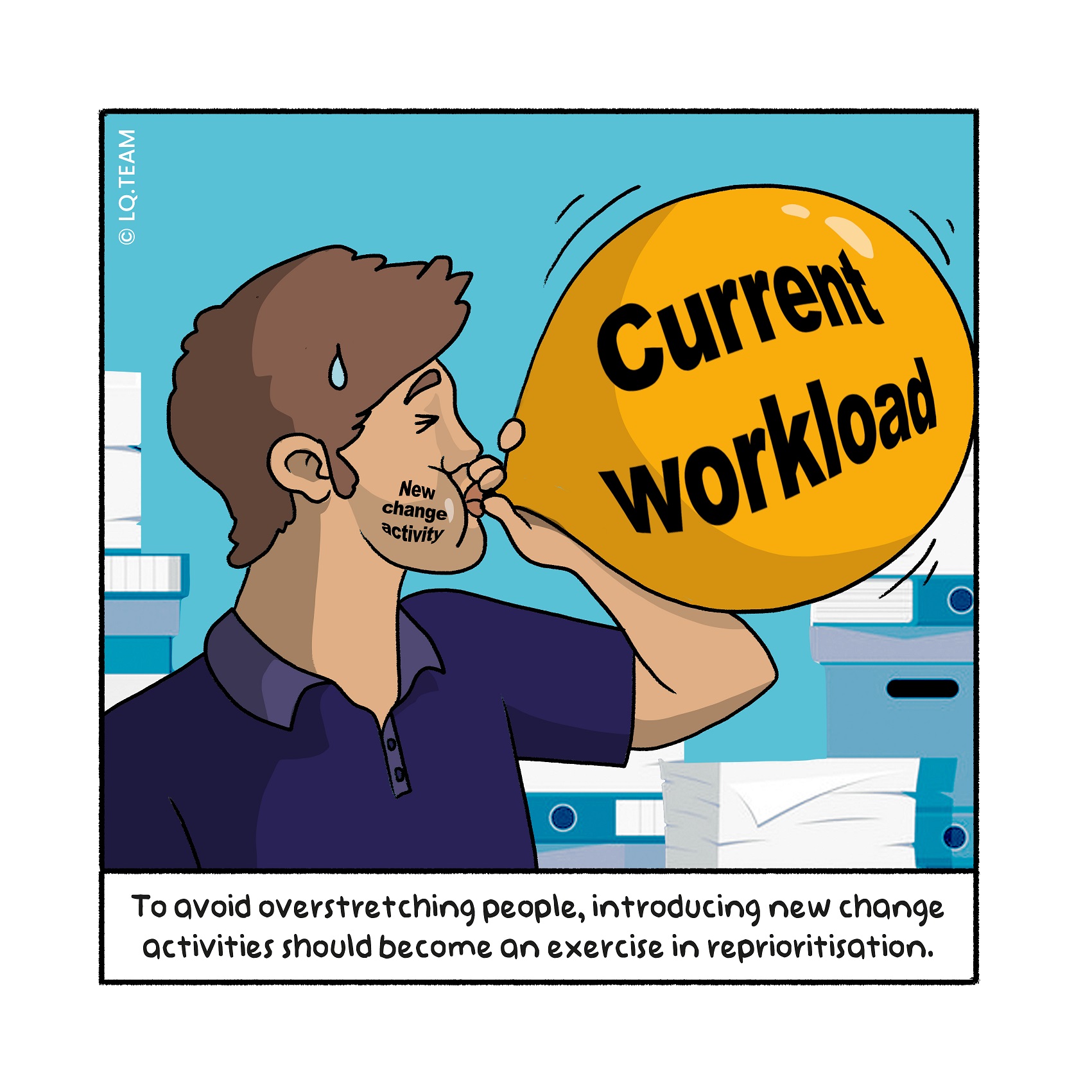
Nut to crack: How do you stretch without over-asking?
How do you make sure that people in the organisation can cope with com- bining their daily recurring activities with leading change? And how do you ensure a pace at which people can maintain this, in the long term, without paralysing or draining the organisation? Finding the right pace is a continuous balancing act in which an intelligent change strategy helps. So, how do you find the right pace?
Nutcracker: Stop before you start
Suppose you ask five people to hold a glass of water while keeping their un- supported arms straight. This is perfectly manageable for about five minutes while simultaneously being able to concentrate on your story. After that, all attention will shift to the increasingly painful arm. This example symbolises the maximum stretch you can demand from people in organisations in times of change. If you ask people to hold that glass of water for too long, all atten- tion will go to the pain, and besides their health and well-being, their daily activities and the change agenda will be jeopardised.
Adding the change programme to the daily agenda is like asking employees to hold out a glass of water, as described in the example above. This typically means you overload people, which is not a sustainable formula. That is why the trick is to position the change agenda and the current business agendas as integral, with one set of kpis. Naming new change activities becomes an exercise in reprioritisation. Stopping doing something or winding something down so you can free up people and resources is just as important as starting something. It is crucial to examine the portfolio of programmes, projects and new activities with a critical eye. Change activities may contribute positively to long-term kpis but often cause a dip in financial results in the short run. The pri- ority and capacity management tool can help to set realistic ambitions. Endur- ance sports inspire us to consider and reconsider the desired pace of change.
Support tool: Priority and capacity management tool
To establish priorities at the organisational level, it is essential to list the dif- ferent projects that are being carried out in an organisation at any given time and to link them to the value they generate for the organisation; thus, the fi- nancial value, customer value, internal value or value in terms of learning and growth. Next, you compare each of the projects against the core elements of the business strategy, and assign a score for the extent to which an individual project contributes to the realisation of part of the business strategy and its value. This score quickly reveals what strategic relevance projects have. It also shows the gaps in the change agenda.
Based on this simple analysis, it is easier for management teams to determine which projects to stop, reduce or phase out faster, allowing resources to be reallocated to more critical initiatives or new initiatives.
To gain insight into the individual impacts on staff, you can go a step further. On the vertical axis, you place the names of individuals who play a role in change processes. Change initiatives are on the horizontal axis. By system- atically mapping who plays which role in which initiative, it becomes apparent whose shoulders carry the heaviest burden and whose could carry a bit more.
Real-life example: The right pace – lessons from endurance sports
A manager questions whether the current pace of transformation is at maximum speed, or whether breaking point, where more pressure leads to fewer results, is approaching. She draws a parallel with endurance sports. Individuals, teams and organisations have a maximum performance capacity comparable to the performance capacity of a human body during endurance sports. Like in endurance sports, a change process requires performance in the here and now, as well as building extra muscle mass for the future. In endurance sports, therefore, you follow a progressive training schedule. That way, you build up your muscle mass without overasking. This applies to a change process in the same way. If you suddenly overload the organisation, injuries will occur. If you exercise too little, you will develop insufficient additional muscle mass. Endurance sport also requires economic use of energy. You need to make choices, use ritualised routines to save energy and organise for recovery after a peak. So, just like endurance sports, use the energy sustainably during a change process. Proactively choose what not to do. Develop rituals to learn new behaviour and to let it take root. And ensure active recovery after peak times. This way, you maintain performance capacity in the longer term.
Tip for change leader
How sustainable are you in your energy consumption? Can you maintain this pace per manently? Put the pace of change on the agenda of your teams. To set the scene, invite a speaker from endurance sports to introduce this topic before you discuss with fellow change leaders how to optimise the pace and help each other endure the change journey.
Tip for change enabler
Although it is a cumbersome task, it pays to plan the capacity of teams in detail. This en ables change leaders to have a datadriven discussion about the staffing of the change processes and to move away from general statements such as “one should just add that”.
Kernel: Balance the pace for sustainable change performance
Managing change is as much about resting as it is about accelerating. Think of change as endurance and build on the same design principles to maintain performance. And if that doesn’t do the trick, turn to Challenge 48 for more inspiration.
